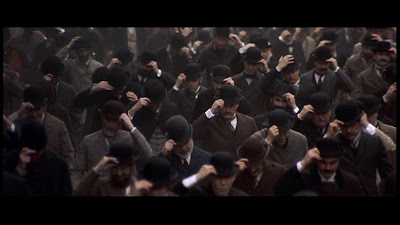Thursday, April 30, 2009
Tuesday, April 28, 2009
Monday, April 27, 2009
Sunday, April 26, 2009
Saturday, April 25, 2009
Tuesday, April 21, 2009
nobody does it better
Monday, April 20, 2009
'In C' Terry Riley

A Stoner’s Revolt
Terry Riley’s In C, the founding work of minimalism, finally makes it to Carnegie Hall.
* By Justin Davidson
I am lying on the floor, bathing in gentle eddies of music. This seems like the most sensible position in which to hear Terry Riley’s In C, a work of radically blithe eventlessness. A piano tolls high C’s for an uninterrupted hour, while underneath a varied ensemble interweaves pattern with burbling pattern. The music evokes no journey, produces no tension, excites no expectations, requires no relief. To sit up seems aesthetically incorrect.
Since its premiere at the San Francisco Tape Music Center in 1964, In C has been working its narcotic magic in lofts, art galleries, and auditoriums around the world, and on Friday it finally finds its way to Carnegie Hall. David Harrington, a founding violinist of the Kronos Quartet, has assembled a large and disparate ensemble of musicians from several generations, united in reverence for this work. “All egos will be checked at the front door, and we’ll just start experimenting,” Harrington says. Expect a disciplined be-in.
Minimalism’s founding document is the barest of scores: one page containing 53 little packets of melody, which range from a single note to a brief phrase, plus a page of suggestions for holding a performance together. Keeping up the pulse requires stamina and concentration. The patterns can line up or not—a cellist may find herself a few patterns ahead of the saxophonist at her shoulders. The piece ends when everyone has settled on the final oscillation of G and B-flat.
The work mutates to suit the players. Bang on a Can’s recording is lean, hard, and, at 45 minutes, relatively short. The Shanghai Film Orchestra recorded an even more compact version full of clanging Chinese percussion and sliding strings. The conductor Paul Hillier deployed a choir of marimbas and wordless voices. Carnegie Hall’s extravaganza should yield a rich, polychrome stew of sound that will simmer for a couple of hours.
Riley didn’t invent the use of happenstance, or the sound of almost nothing going on, but he did renegotiate the relationship between composer and audience. Instead of steering listeners through an aural topography full of threats and havens, he offers a liquid plain, featureless and pleasant, and sets listeners adrift. My mind meanders until I trip on a sharp thought: The title is a provocation and a lie.
After all, modernist composers had for decades twisted themselves into pretzels to avoid any hint of a key, as if tonal harmony were a form of infection. Riley defiantly reclaimed it, but in a form so distilled as to have lost its meaning. Traditional tonal harmony gives music its sense of motion. When Beethoven, say, wrote a long piece in the key of C major, it behaved like a trained falcon, wheeling away from its tonal perch in a widening gyre of harmonies, before returning to safety at the end. Riley’s work gestures vaguely in various directions, but its ringing C’s keep it so resolutely tethered in one place that it’s not really in any key at all.
Minimalism began with this apotheosis. You couldn’t come up with something at once simpler and more sparkling than In C, or more relentlessly chugging yet so infinitely slow. The piece should have led into an aesthetic cul-de-sac; instead it launched a movement. Many composers simply splashed along in Riley’s placid wake, but some acolytes produced intense and richly satisfying music. Steve Reich adopted Riley’s patterns but not his laissez-faire approach: His music is precisely engineered, its forces meticulously calculated. John Adams used early Riley’s repetitive simplicity as a canvas, which he has gradually overlaid with lyricism, darkness, and complexity. Minimalism bloomed into something closer to its opposite.
Conceived by a stoned composer on a San Francisco bus, In C has changed lives along the way. I’ll admit that by the time I first heard it, I was inured to its white-note bliss, perhaps because it had already acquired mythic status and a retinue of knockoffs. The piece denies the existence of boredom—something I am not prepared to do. Yet here on the floor, in the right frame of mind, I can feel the sheer pleasantness of that harmonic cloud shimmering into the room. I am alone with music, and I am content.
taken from NY Magazine (.com)
Sunday, April 19, 2009
Thursday, April 16, 2009
Subscribe to:
Posts (Atom)










































